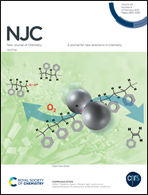Fluorescence ‘off–on–off’ signaling with zinc ensemble: a new array of investigating prevalence of ATP in liver cancer cells†
Abstract
A unique fluorescence chemosensing method has been introduced to explain a new strategy for the simultaneous selective determination of ATP quantitatively. 2-Hydroxy naphthaldehyde–picolylamine conjugate (NPAC) ensembles with Zn2+ (NPAC–Zn2+), which further binds with ATP through an “off–on–off” mechanism. UV-vis and fluorescence measurements, NMR titrations, and TDDFT calculations have been performed in order to understand the sensing mechanism and the electronic properties of the receptor–donor complex. The chemosensing method has been successfully applied in human cancer cells to detect and quantify ATP therein.



 Please wait while we load your content...
Please wait while we load your content...